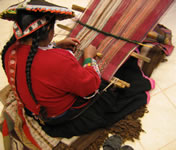
|
The World of Crafts |
|
|
| Home page ---> Glass ---> Glass Bead Making in Daabaa, Ghana |

|
The World of Crafts |
|
|
| Home page ---> Glass ---> Glass Bead Making in Daabaa, Ghana |
| Mr. Asumado learned how to make recycled glass beads from his uncle. He now runs a family-owned studio in Daabaa, Ghana. For more information, please call him at 243575557 or email him at beadsin.dusbeads@Gmail.com | |
 |
 |
 |
 |
 |
| Glass windows and bottles are ground into fine powder in this mortar. | Stacks of fired clay molds wait to be filled with glass powder. They may be reused many times, even when broken. | Cassava stems, that form the holes in the beads, are harvested from plants that grow outside the studio. |
 |
 |
 |
 |
| Terracotta clay is modeled into a disk, cut to size, then stamped with a shaped wooden tool (the spike secures the cassava stem). The mold will be fired to 800o to 1000o C to prepare it for bead making. | |||
 |
 |
 |
 |
 |
| A dry cassava stem is placed in the central depression, then cut. For single colored beads, the glass powder is poured all over the mold, the mold is bumped on the side to settle the powder, then it is tilted so that the excess may be wiped off with a feather. The cassava stem will burn out during firing and form the hole. | ||||
 |
 |
 |
 |
| The kiln was constructed from local red clay. It was covered with a liquid clay mixture to fill in the cracks right before firing. The filled molds were put in the kiln, the kiln was heated for 10 minutes, more fuel was added, the molds were fired for 20 to 35 minutes at 600o to 800o C until the glass powder melted, then the molds were removed from the kiln to cool. | |||
 |
 |
 |
| Horizontally striped beads are made by layering several colors of glass, one over the other. The dried cassava stem is laid into the mold to form the hole, then the powdered colors are added layer by layer. . . | ||
 |
 |
 |
| . . . by layer. | ||
 |
 |
 |
 |
| The fired beads are turned over in the mold, then reheated to form the other side. After cooling, the rough edges are ground off by rubbing them by hand on a wet abrasive stone. | |||
 |
 |
 |
 |
| To create barrel-shaped beads, two fired halves are joined with a piece of dry cassava stalk, placed back in the mold, then re-fired (to join them together). | Smooth beads are strung, then washed on a wet stone. | ||
 |
 |
 |
 |
| Monica Asumado inserted a piece of dry cassava stem into a fired bead to support it while she painted it with ceramic colorant (that has been mixed with water), then she put it back into the mold with the stem so that it could be re-fired. The stem fires out and the colorant melts and adheres to the beads. | |||
|
Links: Bead Making in Odumase Krobo, Ghana Adinkra in Ntonso, Ghana Ashanti Kente Weaving in Bonwire, Ghana Ashanti Kente Weaving in Adawomase, Ghana Ewe Kente Cloth Weaving in Denu, Ghana Lost Wax Casting in Krofofrom, Ghana Ga Coffins in Teshie, Ghana Carol Ventura's Home Page |
| Web page, photographs, and text by Carol Ventura. |